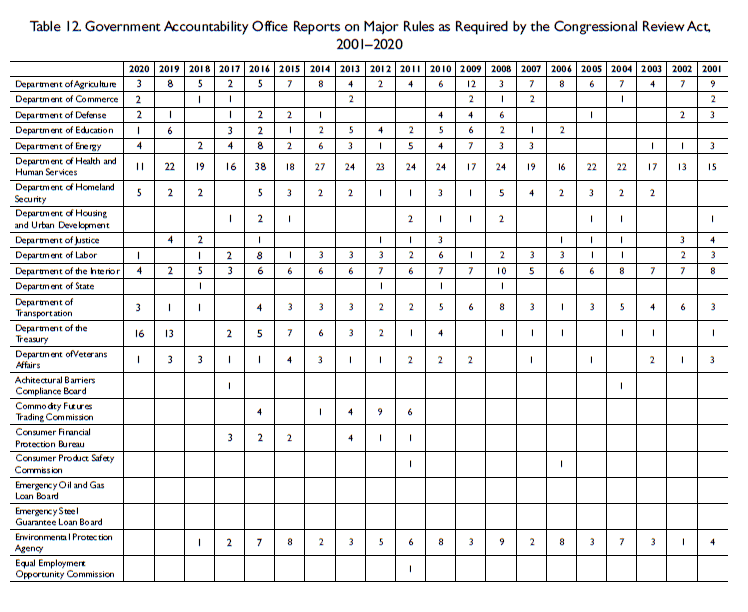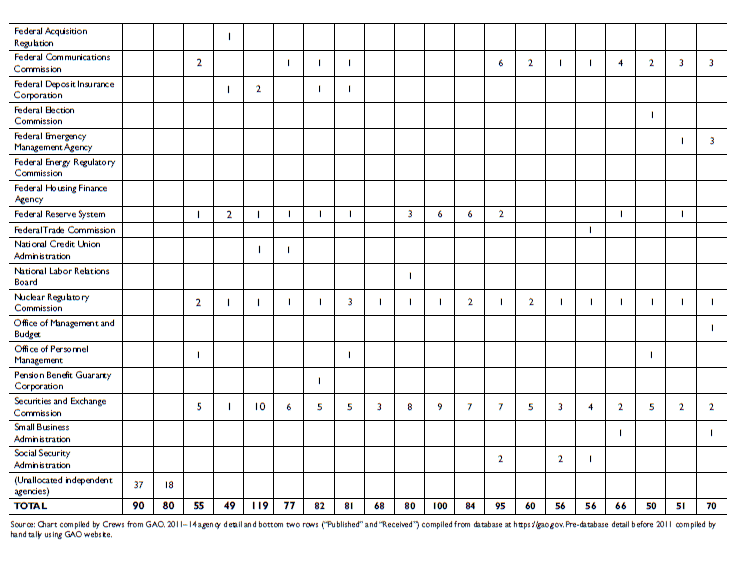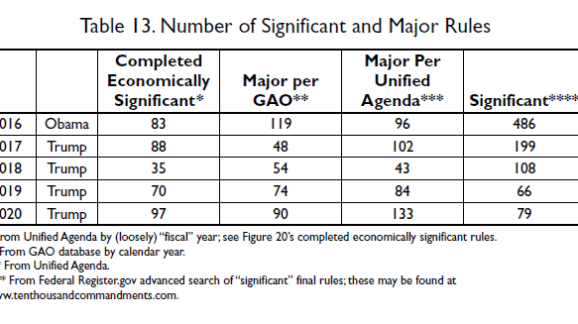Government Accountability Office Database on Regulations
Ten Thousand Commandments 2021 - Chapter 9
Download Chapter 9 as a PDF
The various federal reports and databases on regulations serve different purposes:
- The Federal Register shows the aggregate number of proposed and final rules—both those that affect the private sector and those that deal with internal government procedures or programs—and numerous notices and presidential documents.
- The Unified Agenda depicts agency regulatory priorities and provides detail about the number of rules at various stages in the regulatory pipeline, rules with economically significant effects, and rules affecting small businesses and state and local governments.
The 1996 Congressional Review Act (CRA) requires agencies to submit reports to Congress on their major rules—those with annual estimated costs of $100 million or more. Owing to such reports, which are prepared and maintained in a database at the Government Accountability Office, one can more readily observe (a) which of the thousands of final rules that agencies issue each year are major (to the extent the directive is obeyed) and (b) which departments and agencies are producing the major rules.
The CRA gives Congress a window of 60 legislative days in which to review a received major rule and pass a resolution of disapproval rejecting the rule. Despite the issuance of thousands of rules since the CRA’s passage, including dozens of major rules, before 2017, only one had been rejected: the Department of Labor’s rule on workplace repetitive-motion injuries in early 2001. Since the start of the 115th Congress in January 2017, the CRA has been used 16 times to overturn regulations. According to recent analysis, however, some final rules are not being properly submitted to the GAO and to Congress as required under the CRA, and major guidance is rarely submitted.
Major rules can add burdens, reduce them, implement delays, or set rates and standards for major government programs like Medicaid. Table 12 depicts the number of final major rule reports issued by the GAO regarding agency rules through calendar year 2020. Based on a search of the GAO’s database, 90 major rules were reported in 2020 (80 in 2019), a significant increase from the 55 in 2018 and 49 in 2017. The 119 major rule reports in 2016 under Obama (disregarding inauguration dates) were the highest count since this tabulation began at the GAO following passage of the CRA; the 100 rules in 2010 were the second highest. The 49 under Trump in 2017 were the lowest count since these records began, followed by 50 in 2003.
There are several categories of significant rules. An economically significant rule is major, but a major rule is not necessarily economically significant, so there are fewer economically significant rules than major ones (see Table 13). The basic relationship is as follows: Economically significant includes major, which includes significant. Both economically significant and major rules qualify as significant. Numbers of each over the past four years appears as follows:



Note that the economically significant rule counts are larger than the GAO’s count of major or significant rules in some instances. There may be different explanations, such as (a) calendar and fiscal years not aligning, (b) rules not being reported to the GAO but being noted at OMB, (c) independent agency rules appearing under different categorizations in various databases, or (d) differing treatment of budget/transfer rules. An executive order or legislation to systematize nomenclature could help bring greater clarity, reconcile record keeping across various government databases, and subject independent agencies to greater oversight by Congress and the public.
According to the GAO compilation, President Barack Obama issued 691 major rules over eight years, compared with President George W. Bush’s 504 over eight years. (This presentation uses calendar years, so Bush’s eight years contain the final weeks of President Bill Clinton’s presidency, before Bush’s inauguration, and Obama’s first year includes the Bush administration’s final weeks.) President Bush averaged 63 major rules annually during his eight years in office. President Obama averaged 86, a 36 percent higher average annual output than that of Bush. Trump issued an average of almost 69 major rules annually—49 in 2017, 55 in 2018, 80 in 2019, and 90 in 2020—some of which were deregulatory.
